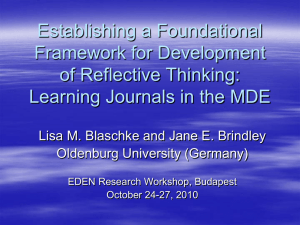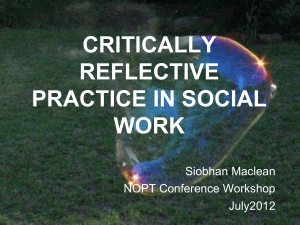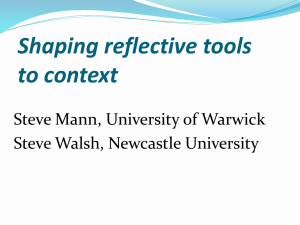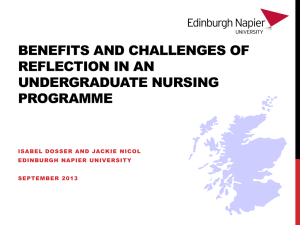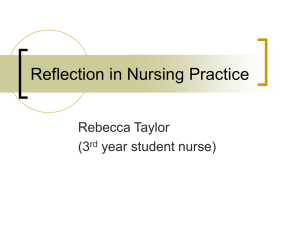Theory & Reflective Practice in Social Work Learning
advertisement
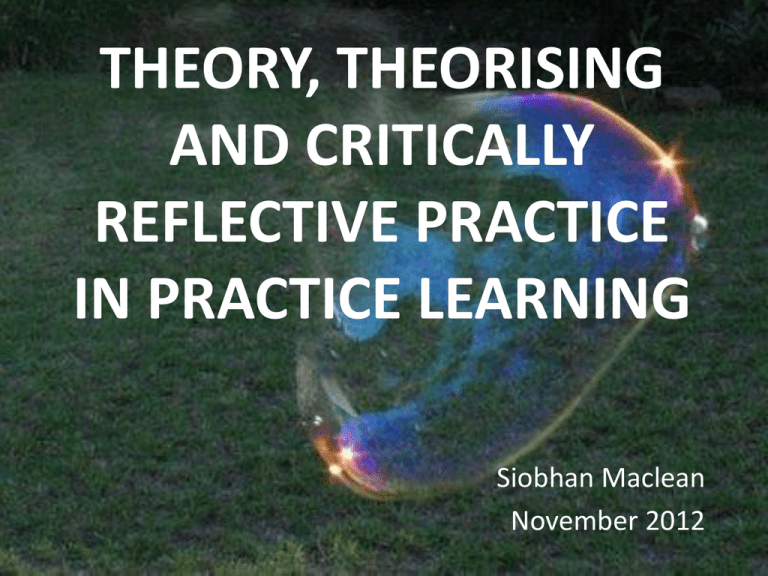
THEORY, THEORISING AND CRITICALLY REFLECTIVE PRACTICE IN PRACTICE LEARNING Siobhan Maclean November 2012 Ask a student or even a qualified social worker what theory are you using there? And …. Ask a social worker what legislation they are using and they know – chapter and verse…. We are leaving ourselves open to direction from others…. “Social work is what social workers do” (Health and Social Care Bill 2011) International Definition of Social Work “The social work profession promotes social change, problem solving in human relationships and the empowerment and liberation of people to enhance well-being. Utilising theories of human behaviour and social systems, social work intervenes at the points where people interact with their environments. Principles of human rights and social justice are fundamental to social work.” My Eureka Moment! Theory – noun – ‘naming’ word Theoretical – adjective – ‘describing’ word Theorising – verb – ‘doing’ word Theorising is putting ideas into action and drawing ideas out of action. 6 Reflective practice : what is it? • Process of review to inform learning (eg: Schon, Reid etc) • Active, persistent and careful consideration of any belief or supposed form of knowledge (Dewey 1933) • Mental process of trying to restructure existing knowledge and insights (Korthagen 2001) WHY IS IT SO IMPORTANT FOR SOCIAL WORK STUDENTS? 8 Key aspect of professionalisation Active CPD activity Improves accountability Supports theorising – using theory in practice and drawing theory out of practice Improves practice (Munro – critically reflective organisations) Ensures ethical practice Enhances a practitioner’s ‘core’ and their resilience Social Workers who fly….. Grant and Kinman (2009) research into the professional development of newly qualified workers identified two key factors that: Enhance resilience to stress Foster wellbeing Are key qualities of those social workers who “fly” after they qualify. 10 Emotional intelligence Reflective abilities Critically reflective practice: key components Rethinking / deconstructing power Awareness of values and implications for practice Exploring emotions / emotional intelligence Drawing on knowledge / developing knowledge and practice wisdom Self awareness Creating uncertainty through dynamic questioning – willingness to live with that uncertainty 12 13 Safeguarding practice: key issues Power and powerlessness Changing societal values Emotional impact / distress Developing / emerging knowledge Impact of personal experiences / values (self awareness) More questions than answers (uncertainty) 14 POWER VALUES EMOTIONS KNOWLEDGE SELF AWARENESS UNCERTAINTY 15 Reflective Practice: Power • Fook – critically reflective practice • Deconstruction of ‘realities’ with a focus on power dynamics Reflective Practice: Self Awareness Personal process relies on personal awareness Distress and emotions Reflection and self awareness are key aspects of emotional intelligence – “keeping distress from swamping the ability to think, to empathise and to hope” (Goleman 1996) Drawing on Knowledge Knowledge is fixed and creates limitations to the way that we see things…… Knowledge is time, context and societally and culturally specific.. 19 Freud’s Seminar ‘The Ateology of Hysteria’ (1896) “Almost all of my women patients told me that they had been seduced by their father. I was driven to recognize in the end that these reports were untrue and so came to understand that the hysterical symptoms are derived from phantasies and not from real occurrences…… It was only later that I was able to recognize in this phantasy of being seduced by the father the expression of the typical Oedipus complex in women.” (Sigmund Freud 1933) 20 Reflective processes can potentially unearth any assumptions about anything…. Some crucial but hitherto deeply hidden assumptions may be uncovered. (Fook 2004) 21 The earth was flat………. Child sexual abuse didn’t happen…. Sula Wolff (1973) Seminal text No mention of child sexual abuse 10 years on….. Judith Herman “This disturbing fact…. Has been repeatedly unearthed in the past hundred years, and just as repeatedly buried….. The information was simply too threatening to be maintained in public consciousness.” (1982:7) 24 Kristy Bamu’s murder raised issues of beliefs in witchcraft and evil spirit possession – but this issue has been raised a number of times since the deaths of Victoria Climbie and Khyra Ishaq. ……………..is this information “simply too threatening to be maintained in public consciousness?” 25 Critically reflective practice recognises that there is no truth and that we need to be open to all possibilities….. An ability to “imagine” or think beyond knowledge Despite the known importance of critical reflection there are a number of barriers…. Difficulties / barriers Time constraints Striving for certainty Evidence based practice Reflective practice can be painful and create a crisis of confidence Organisational constraints Lack of reflective supervision Lack of clarity about reflective practice So how can we support students to be more reflective? Support them to find a model of reflective practice which they are comfortable with – this will vary for each individual Enable them to understand the need for “critical friendships” – and be a critical friend to them during placement Develop their awareness of what is impacting on their reflection Make sure that they don’t avoid the questions – but likewise don’t delay actions Critical Friends…. Introduced by Stenhouse (1975) as a method to support action research. Research indicates that whilst having a critical friend is useful, acting as one is even more helpful to professional development (Dahlgren et al 2006) Schön Reflection in action Reflection on action reflection for action (Killian and Todnem 1991) Reflective cycle Plan – reflection for action Do – reflection in action Review – reflection on action So what are the models? Remember Schön is a theory of reflection not a model – it highlights the need to do it but not how to do it! The models include: • Gibbs • Borton • Boud, Keogh and Walker • Fook • Korthagen Theorising on practice Examples of students and practitioners theorising on models of reflective practice… RACHEL RAYNER HAIR-RAISING MOMENTS What were the moments that made you think “wow”? i.e. the things that shocked you; That you were not expecting? What gave you goose-bumps? TUMMY-SINKING MOMENTS What are the moments you think did not go as hoped? What, if anything, gave you the “sinking feeling”? i.e. what might you do differently next time? HEART-WARMING MOMENTS What went well? What made you feel good about your work/practice? What are you proud of? TOE-CURLING MOMENTS What were the moments that made you feel uncomfortable? The moments that you had not/could not plan for that you learn from the most? i.e. the moments that in years to come you will look back and say, “I remember… and these “awful” moments are often the ones that we learn from the most. Practice Educators: The Roller Coaster Before you get on the ride – what are you expecting? Any apprehensions? etc During the ride – how does it feel? Do you want to get off? etc After the ride – how do you feel? What was it like? etc POWER – who put you on the ride? Did you have any choices? etc “The weather model” Sunshine – what went well? What felt good? Rain – what didn’t go so well? Lightening – what came as a shock? Fog – where did you get lost? What couldn’t you see? Why? The Cake model (Welsh Practice Educators) Preparation What ingredients have you got? What recipe are you using? How are you feeling about making the cake? Making the cake Did you follow the recipe? Did you add any spice? Did you make a mess? If so, how did you tidy it up? Cont…. Digesting the cake Did you burn your fingers? Did you share the cake? Did it sink or did it rise? What did it taste like? If you had changed the ingredients would it have tasted the same? Did you cater for all tastes? What was the “icing on the cake”? Reflective practice is more than the icing on the cake……. It is the cake And we can have our cake and eat it………. SOME OF THE TRADITIONAL MODELS…… 46 Gibbs (1988) Stage 1: Stage 2: Stage 3: Stage 4: Stage 5: Stage 6: Description Feelings and thoughts Evaluation Analysis Conclusion Action planning GIBBS Borton (1970) What? So what? Now what? Boud, Keogh and Walker (1985) An individual: recaptures their experience thinks about it mulls it over (perhaps with others) evaluates it acts on the reflection Korthagen’s reflective onion o Environment o Behaviour o Competences o Beliefs o Identity o Mission Jan Fook 1. Telling the narrative – ‘describing’ the practice. 2. Deconstruction – reflective questioning, exploring practice. Focus on power. 3. Reconstruction – planning future practice and putting the plans into action – again focus on power. Kolb: Experiential learning Concrete experience Reflective Observation Abstract Conceptualisation Active Experimentation - What was the event? - What are your personal thoughts and feelings about the experience? - How can you draw on previous experiences and on your knowledge to help you ‘make sense’ of this experience? - If this event were to occur again, what would you do differently? - What additional knowledge do you need to gain? Williams and Rutter (2007) based on Gibbs Description: What happened? Feelings: What were you thinking and feeling? Evaluation: What was good and bad about the experience? Analysis: What sense can you make of the situation? Conclusion: What else could you have done? Action Plan: What was learnt? If it arose again, what would you do? References Brookfield, S. (ed) (1988) Training Educators of adults: The Theory and Practice of Graduate Adult Education. (New York) Routledge. Borton, T. (1970) Reach, Teach and Touch. (London) McGraw Hill. Boud D, Keogh, R. and Walker, D (1985) Reflection: Turning experience into learning. (London), Kogan Page. Burnham, J. (1993)n Systemic Supervision: the evolution of reflexivity in the context of supervisory relationships, human systems. The Journal of systemic consultation and management, 4 (3-4) pp349-381. Dewey, J. (1933) How we think: A restatement of the relation of reflective thinking to the educative process. (Boston) DC Health. Dahlgren, L.O. Eriksson, B.E., Gyllenhaamar, H. Korkeila, M. and Saaf-Rothoff, A. (2006) to be and to have a critical friend in medical teaching. Journal of medical Education, 40 (1) pp.5-6. 57 Dreyfus, H.L. and Dreyfus, S.E. (1986) Mind over Machine: the power of human intuition and expertise in the era of the computer (Oxford) Basil Blackwell. Fook, J. (2004) Critical Reflection and Organisational Learning and Change: A Case Study. In Gould, N and Baldwin, M. (eds) Social Work, Critical Reflection and the Learning Organisation. (Aldershot) Ashgate Publishing. Gibbs, G. (1988) Learning by Doing: A Guide to Teaching and Learning Methods. (Oxford) Further Education Unit Oxford Polytechnic. Grant, L. and Kinman, G. (2009) developing emotional resilience in social work students: supporting effective reflective practitioners. Presentation at JSWEC Conference 2009. Korthagen, F. (2001) A Reflection on reflection. In Korthagen, F. Linking Practice and Theory: The Pedagogy of realistic teacher education. (New Jersey) Lawrence Erlbaum Associates Mezirow, J. (1981) A Critical Theory of Adult Learning and Education. Adult education 32, pp. 3-23. Reid, B. (1993) But we’re doing it already! Exploring a response to the concept of reflective practice in order to improve its facilitation. Nurse Education Today, 13 pp305-309. Schon, D. (1983) The Reflective Practitioner: How Professionals think in action. (London) Temple Smith. 58 Stenhouse, L. (1975) An Introduction to Curriculum Research and Development. (London) Heinemann.

